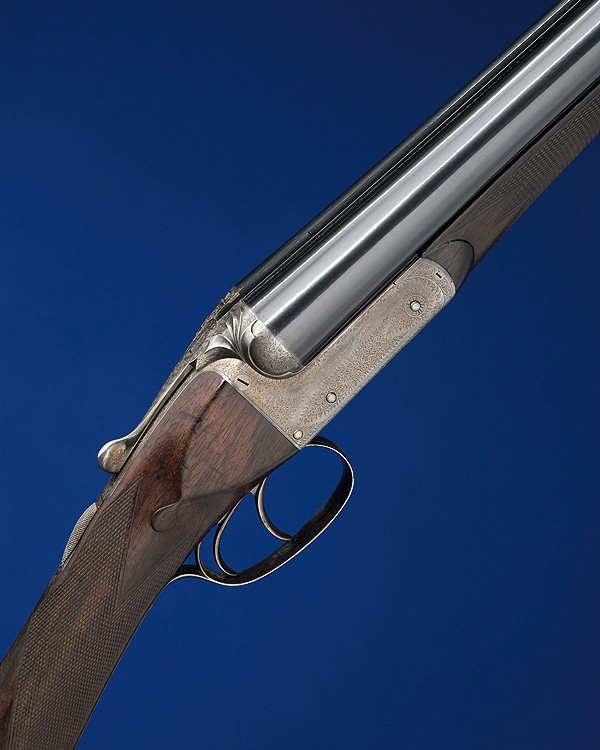News
Second-hand Guns – Guns for the common man
<strong>Robin Marshall-Ball puts the case for the side-by-side, a piece of England's past that has stood the test of time and is again finding favour in the field</strong>
Would you like to speak to our readers? We offer sponsored articles and advertising to put you in front of our audience. Find out more.
Mention the words English shotgun, even to a member of the non-shooting public, and the names of Purdey, Holland & Holland and Boss, the trinity of our most prestigious and world renowned gunmakers, might well be recognised. These are synonymous with the best firearms the world has to offer and customers include crowned heads, millionaires and captains of industry. These are guns for the elite of the sporting world.
But what of guns for the common man? Nowadays the shotgun market is flooded with imports from abroad, the majority being over-and-unders or self-loading semiautomatics. These are the shotgun types currently in vogue, but there are still a number of situations where the user of a self-loader may find himself looked upon with suspicion. Often a break open gun is the order of the day and an over-and-under will be acceptable. Even today, however, there exist some more traditional shoots where an up-and-over job is viewed as a bit brash and the side-by-side is the norm. Casting fashion and prejudice aside, what are the perceived disadvantages that made the side-by-side lose its dominance?
International influences
By the early 1900s, gunmakers in Britain had more or less standardised the layout of the side-by-side. The Best quality guns, bar-action sidelock ejectors from the prestigious makers, are virtually identical to the guns made today. The factories of London, Birmingham and provincial towns produced huge quantities of less costly sidelocks and boxlocks to cater for a range of customers, from country squires to yeoman fishermen/fowlers. These guns were all side-by-sides. With the exception of heavy wildfowling guns, the refinements in British gun design through the early 20th century sought to reduce the shotguns weight, culminating in the Lancaster Twelve-Twenty and the 2in chambered 12-bore.
On the other side of the pond, the reverse was happening. The evolution of reliable self-loaders and pump-action shotguns gave the Americans a heavy weapon with a single sighting plane straight down the rib of a single barrel. An over-and-under gave them the same sight image and, though it was pioneered in Britain, the Americans took to the overand-under in a big way. With the increasing popularity of clay pigeon shooting, heavy over-and-unders and semi-autos capable of absorbing the recoil of sustained competition shooting became the norm.
Clayshooters in this country followed the American lead and in the post-war years, the over-and-under began to permeate the realms of gameshooting and roughshooting, bringing with it an influx of inexpensive guns from Russia, Japan and southern Europe. The virtues of the single sighting plane were extolled to all that would listen on the clay ground and beside the covert, and the fact that the standard over-and-under was substantially heavier than the equivalent British built side-by-side was ignored. It was this change in fashion that sounded the death knell of most gunmakers in Britain during this period. The provincial gunmakers went first, followed by larger Birmingham concerns such as Greener and the Midland Gun Co.
Luckily, tradition dies hard and there still remained a small market for side-by-sides in this country, which was catered for by a variety of guns coming from the factories in southern Europe. If imitation is the sincerest form of flattery, our gunmaking industry should be flattered indeed. Respected Spanish firms such as AYA, Gorosabel and Arrieta modelled their wares on the traditional English shotgun, basing their sales pitch on terms such as Hollandstyle sidelocks, Yeoman boxlocks and others that were described as
closest to the English ideal.
But what has become of the guns belonging to the squires, farmers and fowlers, the ones that these modern firearms seek to emulate? Where is the working mans gun that was the backbone of Britains gunmaking industry? Many of these guns have been taken to the US, where there is a growing appreciation of the reliability, build quality and artisan craftsmanship of guns from our less prestigious makers. They have stood the test of time and have proved their reliability and worth. Of those that remain in this country, many have been handed down from one generation to the next and are cherished heirlooms, still as effective and reliable in the hands of a new generation of shotgun users as they were when wielded by their grandfathers.
Sadly, others have fallen to the whim of fashion and been traded in for more flashy and modern styles. In most cases, the gundealers heart sinks when these ordinary-grade English side-by-side guns are presented as a trade-in. The trade-in gun is likely to be a wallflower in the dealers rack until, in desperation, he throws it into a sporting auction.
Making a comeback
What goes around comes around, and gradually it seems that the side-by-side shotgun is making a comeback. On my roughshoot they are slowly replacing over-and-unders and, in this environmentally-conscious age, non-ejectors are finding favour better to extract the spent cartridges from the breech than go grovelling in the brambles for ejected empty cases. With a slight resurgence of interest in this traditional style of gun comes a real opportunity. At present the English farmers gun, a side-by-side boxlock, is probably the cheapest gun on the second-hand market. With some degree of irony, the price tag for an English gun is often lower than that asked for a modern Continental one the imitation commands a better price than the real thing.
If you are a pigeon shooter, wildfowler, roughshooter or belong to a small driven syndicate and are looking for a sound and reliable firearm, you may be able to secure an outstanding bargain at one of this summers game fairs. Ignore the stainless steel, raised ventilated ribs and camo gunstocks on the dealers front racks and head for the less prominent rack of side-by-sides tucked away at the back. There you will find an assortment of English guns for the common man from a wide variety of Birmingham and provincial gunmakers of yesteryear. Make the dealer an offer and you could come away with a sound and faithful workhorse of a gun, a little piece of Britains gunmaking heritage and an heirloom you can pass on to your children.
Related articles
News
PETA attacks royal couple for breeding cocker pups
The Prince and Princess of Wales have faced criticism from animal rights group PETA after they had a litter of puppies
By Time Well Spent
News
Farmers launch legal review against Reeves’s farm tax
Chancellor Rachel Reeves faces a judicial review over inheritance tax reforms that could force family farms out of business
By Time Well Spent
Manage Consent
To provide the best experiences, we use technologies like cookies to store and/or access device information. Consenting to these technologies will allow us to process data such as browsing behavior or unique IDs on this site. Not consenting or withdrawing consent, may adversely affect certain features and functions.
Functional Always active
The technical storage or access is strictly necessary for the legitimate purpose of enabling the use of a specific service explicitly requested by the subscriber or user, or for the sole purpose of carrying out the transmission of a communication over an electronic communications network.
Preferences
The technical storage or access is necessary for the legitimate purpose of storing preferences that are not requested by the subscriber or user.
Statistics
The technical storage or access that is used exclusively for statistical purposes.
The technical storage or access that is used exclusively for anonymous statistical purposes. Without a subpoena, voluntary compliance on the part of your Internet Service Provider, or additional records from a third party, information stored or retrieved for this purpose alone cannot usually be used to identify you.
Marketing
The technical storage or access is required to create user profiles to send advertising, or to track the user on a website or across several websites for similar marketing purposes.





